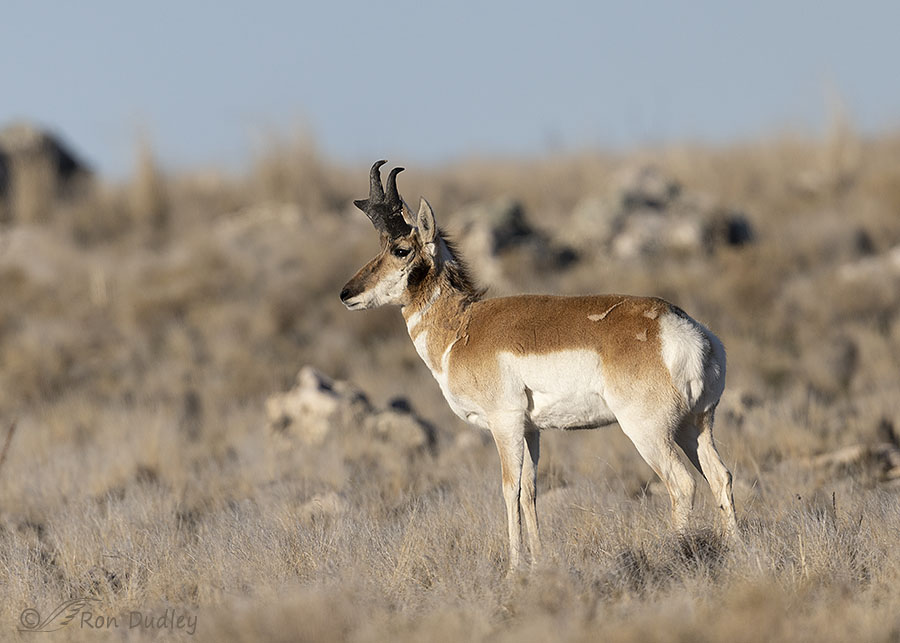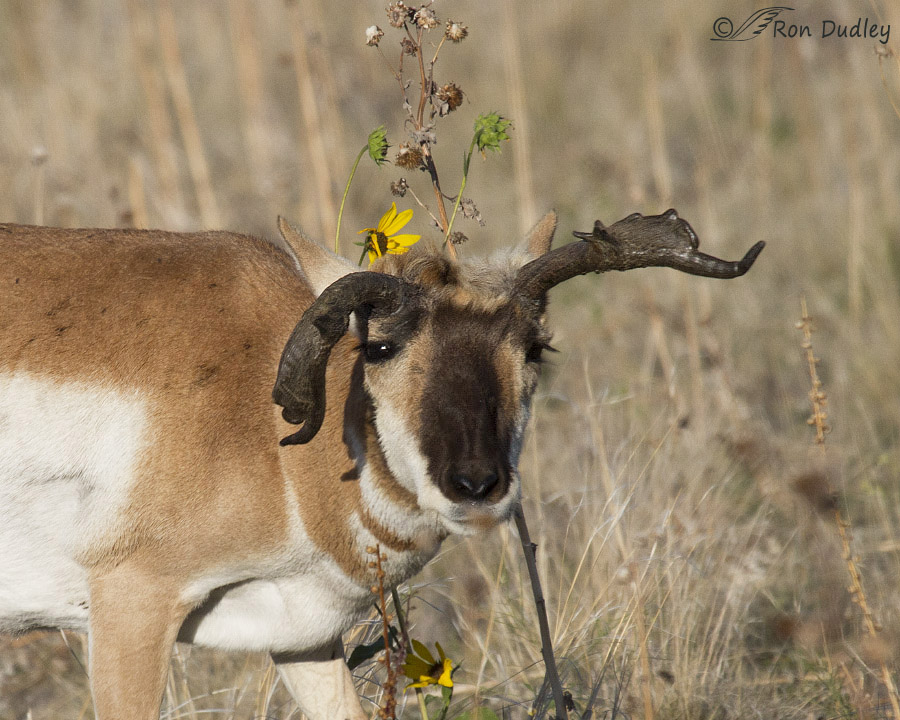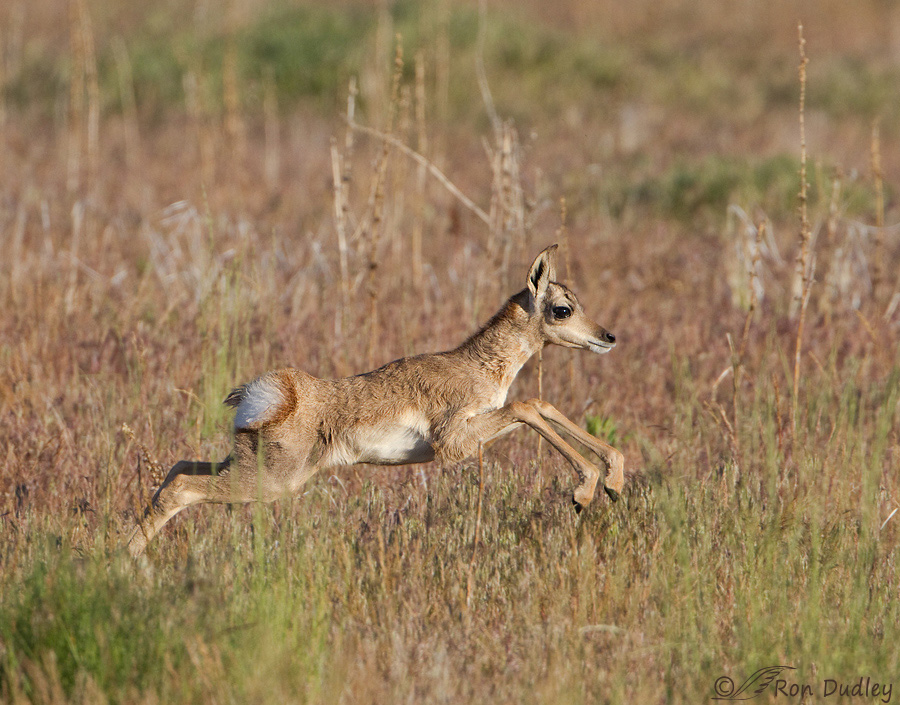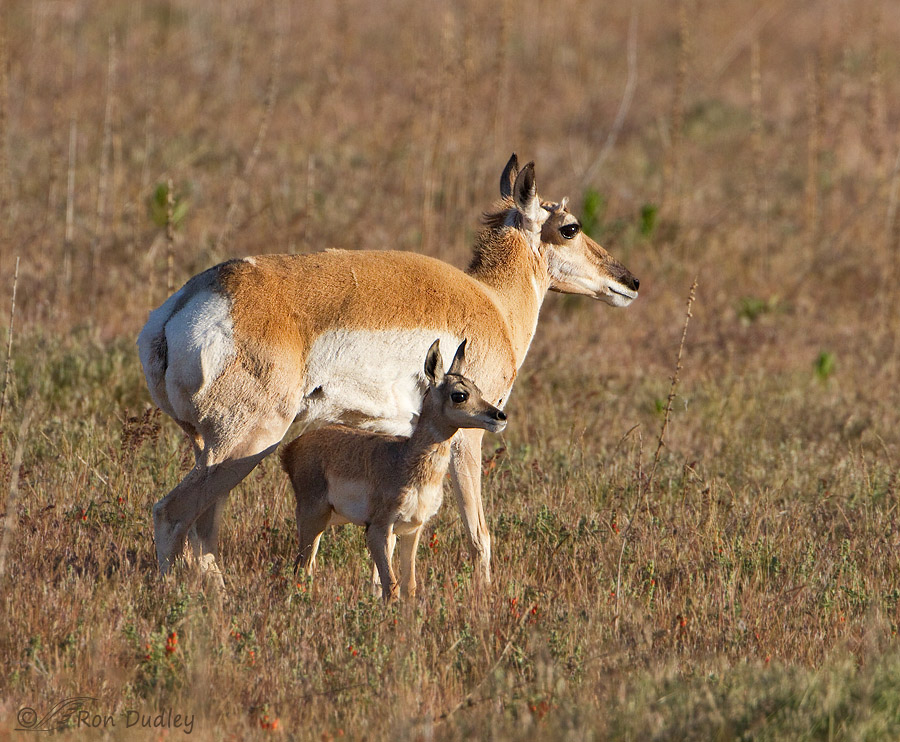I don’t know a definitive answer to that question but I think I have a pretty good guess.
Yesterday when we arrived on Antelope Island soon after dawn my thoughts went to the Pronghorn that I rarely see anymore. In fact I said out loud ” I can’t even remember the last time I saw a Pronghorn on the island”. That statement was a bit of a stretch but not by much. A few times a year I do see a Pronghorn or two in the far-off distance but even those kinds of sightings have become unusual to rare..

So about a half hour later I was very pleasantly surprised to find this handsome buck right next to the road. He crossed the road behind my pickup and slowly walked away to the south. This was as close as he came to giving me a broadside view but he turned enough that I got a good look at his face and a catch light in his eye.
A close look at a Pronghorn on the island has become unusual enough that this guy inevitably brought back memories of what it used to be like on the island. Up until 8-10 years ago Pronghorn seemed almost as numerous as the nearly ubiquitous Bison. It wasn’t unusual to see herds of many dozens of Pronghorn very close to the road and individuals or small groups were easy to find.

I ‘knew’ at least one of them individually. I called this distinctive buck “Curlicue” because of his malformed horns. I saw Curlicue often enough that I became very fond of him. I saw him fairly regularly for two or three years running and then I just didn’t see him anymore. I often wonder what happened to him.

Even in places where Pronghorn are common it’s highly unusual to see very young ones because their mothers keep then concealed in vegetation for the first 3-4 weeks of their lives. But Pronghorn used to be common enough on the island that I’ve been lucky enough to see young fawns a number of times. I photographed this one on the island more than a decade ago as it was racing in circles around its mother.
When I see my photos of this happy little guy the word ‘cute’ inevitably comes to mind, even though that’s a word I try to use very sparingly. Those long gangly legs, club feet and huge dark eyes kinda melt me.

I took this photo a couple of minutes later after the same fawn finished a nursing session with its mother.
I can only guess why Pronghorn are so seldom seen on the island these days but I suspect the primary cause is the same reason most other species of birds and mammals on the island have been similarly affected – the disappearing Great Salt Lake. The water sources of the lake, particularly the Bear River, have been mismanaged by politicians and special interest groups (industry, agriculture and developers) for so many years the lake is now only a small remnant of its former self.
In recent months politicians have finally seen the light but I fear it’s too little, too late. I’d love to be wrong.
Ron


I think climate change has at least something to do with it. Remember the big fire on the Island a few years ago? After that I saw very few chukar and antelope. Now with the drought conditions have worsened.
Absolutely, Deedee. Climate change and drought are very likely contributing factors.
Great photos, the fawns are so adorable and the way they race around must drive the mothers crazy trying to keep tack of them.
When I ride my bike along the south end of the Island I see many pronghorn. The dirt road is now only closed winter months and I think the animals take advantage of the lack of humans. Now the road is open summer months it will be interesting to see if animals go higher or on the back side where there is not access by roads. I think the lack of some animals is due to increased use by humans.
” I think the lack of some animals is due to increased use by humans”
So do I, April – one of the results of overdevelopment on the island.
Good to know there are more pronghorn on the south end where the road’s closed. And that damn road was still closed as of yesterday – another one of my gripes.
When I drive through Wyoming (going from Denver to SLC) I once heard someone at a truck stop refer to these pretty creatures as “prairie maggots.” 🙁 Also, I lived in Denver for ten years. Never saw a Pronghorn until 3 years before I left. Someone told me they were moving further south. I know we have them here in New Mexico. Maybe they’ve just traveled? Fingers crossed
“Prairie Maggots” – that’s a new one me, Arwen. I hate it.
Me too!!!!
I fear you are not wrong. And watch similar things here. The ignorant self centred greed of our species makes me rage and despair. The world is not just ours. And certainly not ours to abuse.
And thank you for a reminder of the beauty and indeed the cuteness of some of the other inhabitants.
It’s pretty much a universal tendency of humans, isn’t it EC.
When you share these kinds of photos they are a celebration of the natural world. Sadly, they are also a kind of history lesson of what was. You may be right about the cause of decreasing wildlife on Antelope island. What there can be no doubt of is, except for natural disasters like earthquakes and tsunami’s, the destruction of the environment is 100% caused by one species.
I’m pretty sure I’m right, Lyle. There may be other contributing factors but the primary one is us screwing things up.
Fabulous photographs.
Magnificent animals.
Cute is the only acceptable word for that fawn.
Devastating chronicle of the area too often repeated around the planet.
Thank you, Wally.
Cute, adorable, whatever adjective fits. They are beautiful animals. I often have to correct new people here who call them antelopes. We have the
same problem with fewer and fewer numbers, but in our case they have been removed to other areas of the state due to so much residential building going on here to provide for the fleeing Californians.
Your photos are excellent as always. I think you have previously shown us the one of the young one running?
Thanks, Everett. Yes, I’ve posted that one before.
Hope you are wrong too Ron. Thanks for this story. Very informative.
Thanks, Michael.
Ron, Would the Coyotes on the island helped whittled the herd down ?
Gary, I don’t think so. Besides, coyotes on the island are in the same ‘boat” as everything else – their numbers are substantially smaller than they used to be.
Tho they don’t need a lot of water, they certainly DO need water! Still plentiful around here at times. A month or so ago there was a herd of several hundred near the road for a few days – probably making their way to their summer grounds. HATE seeing them by the road as they are SO unpredictable…. 😉
Fun shots of both old and new….. 🙂
“they are SO unpredictable”
That’s for darn sure, Judy. Especially when they’re caught between fences on both sides of a road. But in other situations too.
Your sad post today makes me very angry. I hope the local citizens are waking up to the issues and history of mismanagement!
Some of them are “waking up”, Terri. I hope it’s enough of them.
Thank you once again for the beautiful photographs and poignant tale about the vanishing Pronghorns and the vanishing lake! I do hope you are wrong and they will be able to turn back the hand of progress. But I fear you are correct. So sad.
Joanne, I tend to be a pessimist, especially when politicians and the environment are involved, so I try to keep that in mind when I evaluate things like this. Sadly I’m right about such things far more often than I’m wrong.
Bittersweet to see your photos of those handsome animals. About 20 years ago, there were still so many of them outside Prescott, AZ that I loved to see large herds of them “flow” ( the only adequate word for the way that they moved ) across the hills–maybe Everett can tell us if their numbers have maintained or diminished ?
Kris, “Flow” is a good word. Several times I’ve seen herds of 40-50 pronghorn cross the road in front of me and it’s quite a sight.
Glad you were able to see the buck and get such a nice shot of him.
I’ve been watching a series on the Plantagenet kings and it looks like the same greed, lust for political power, and short-sightedness is alive and well in Utah. Instead of beheading their enemies, they’ve eviscerated the environment.
Alive and well indeed, Marty. At least our politicians have finally awakened. To what degree and for how long remains to be seen.
It would take greater strength of mind than I have not to call that gambolling fawn cute. And Curlicue has sweet eyelashes and a cheerful sprig of a chapeau. A descent into the abyss of anthropomorphism.
‘Descend’ all you want, Frances. It seems perfectly appropriate for that little guy.